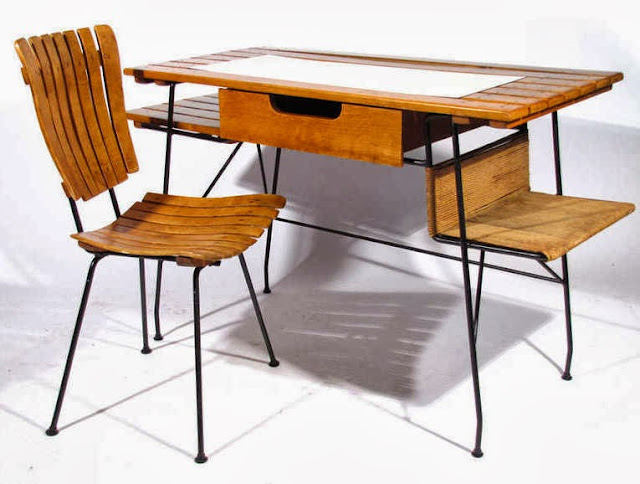When you sell vintage pieces for a living, you see a lot of beautiful things, even though some aren't so beautiful when you find them. You haul them back and forth between the refinisher's and the upholsterer's shops, lug them up and down stairs and into trucks and trailers. You sit on the chairs and sofas, you eat hamburgers at the tables, and your kids play hide-and-seek behind the stacks of inventory in your storeroom. You become familiar with them...and while familiarity doesn't breed contempt in this case, as the old saying goes, it does affect your attitude toward them.
First, there was the
Lou Hodges table that my SIL almost put at the curb. Seriously, moving can make even the most dedicated vintage furniture lover
crazy tired. Fortunately, he got a good night's sleep before he tossed the piece and eventually partnered with Gerard O'Brien at Reform Gallery in Los Angeles to sell it.
 |
| Lou Hodges table, almost tossed |
Then there was the
Richard Galef trash can (like this one I found on Etsy) that was used for dirty diapers when both the grandsons were babies. I'm sure there are lots of people who would treat a designer piece with a little more respect than that. (Although, in defense of my daughter and SIL, I will say that it took us a long time to identify it as a Galef piece. She got it at an estate sale for $1.00.)
 |
Richard Galef trash can for Ravenware
etsy.com - OrbitingDebris |
And, finally, there is the Planner Group coffee table by Paul McCobb that sits, as we speak, in my daughter and SIL's living room. I'll post a picture of one I found on
Gerard's site, because the one we all use on a daily basis is so covered with mail and toys that you can't even see the top of it. We sit on it, eat on it, spill on it, play with toy trucks on it, stand on it and generally treat it as if it's indestructible, which it's proved to be so far.
 |
Planner Group coffee table by Paul McCobb
reformgallery.1stdibs.com |
Does this make us jaded? Unappreciative? Cavalier? I don't think so. These are tools of our trade, just as wrenches and hammers are the tools of other trades. Once they're fully restored and in our store, we handle them very carefully, so they'll be as perfect as possible when customers take them home. When they're in our own homes, we don't abuse them...but we do use them, just as people have been using them for the past 60-some-odd years. We figure if they've held up that long, they'll hold up for a good while longer.
The moral of this story: When you find a piece you just can't live without, buy it. Enjoy it. And don't be afraid to really live with it.
















+p.+100.jpg)






































